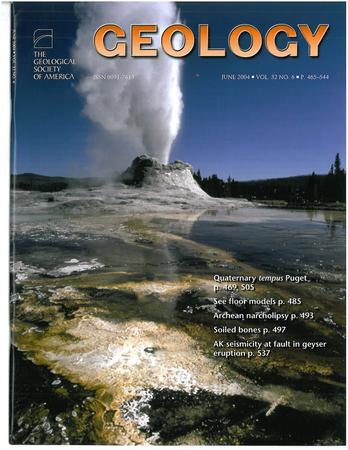方解石到文石海中舌口苔藓虫骨骼矿物学的演化
IF 4.6
1区 地球科学
Q1 GEOLOGY
引用次数: 0
摘要
在方解石-文石海洋假说下,海洋生物钙化的进化史反映了全球海水化学的变化,交替有利于方解石或文石骨架的沉淀。大多数钙化类群,包括珊瑚、球石藻和叠层孔虫,不会因这些变化而改变矿物学;相反,它们会随着它们喜欢的海水条件的变化而膨胀和缩小。毛口苔藓虫被认为是这一规律的一个例外,它们显然在文石和方解石之间多次过渡。这些变化从未被详细调查过,但对材料特性、化石保存和海洋生物适应环境变化的能力产生了重要影响。我们使用新的大规模系统发育、古生物学和矿物学数据集,分析了在早期新生代方解石-文石海过渡时期,唇口动物骨骼矿物学的演变。祖先状态重建和随机特征图表明,至少有50个独立的部分或完全文石骨架来自钙化祖先,向文石状态的转变比远离文石状态的转变要多。在白垩纪,化石动物群几乎完全以钙质物种为主,但在渐新世,双矿物物种变得普遍,在上新世-更新世,文石物种变得普遍。系统发育和化石分析揭示了一个连贯的时间轴,与向文石海的转变相一致。舌骨动物的骨骼发育可能倾向于矿物学上的灵活性,对群体的构建和模块化有适应性的影响。本文章由计算机程序翻译,如有差异,请以英文原文为准。
Evolution of skeletal mineralogy in cheilostome bryozoans from calcite to aragonite seas
Under the calcite-aragonite seas hypothesis, the evolutionary history of calcifying marine organisms reflects changes in global seawater chemistry, alternately favoring precipitation of skeletons made of calcite or aragonite. Most calcifying groups including corals, coccolithophores, and stromatoporoids do not switch mineralogies in response to these changes; instead, they expand and dwindle as their favored seawater conditions come and go. Cheilostome bryozoans have been suggested as an exception to this rule, apparently transitioning between aragonite and calcite many times. These changes have never been surveyed in detail, but have important consequences for material properties, fossil preservation, and the capacity of marine organisms to adapt to environmental change. We used new large-scale phylogenetic, paleontological, and mineralogical data sets to analyze the evolution of skeletal mineralogy in cheilostomes as they diversified across the early Cenozoic calcite-aragonite seas transition. Ancestral state reconstructions and stochastic character maps indicate at least 50 independent acquisitions of partly or fully aragonitic skeletons from calcitic ancestors, with many more transitions toward the aragonitic state than away from it. Fossil faunas are dominated almost entirely by calcitic species in the Cretaceous, but bimineralic species become common by the Oligocene, and aragonitic species by the Pliocene−Pleistocene. Phylogenetic and fossil analyses reveal a coherent timeline consistent with the shift to aragonite seas. Cheilostome skeletal development may be predisposed to mineralogical flexibility, with adaptive consequences for colony construction and modularity.
求助全文
通过发布文献求助,成功后即可免费获取论文全文。
去求助
来源期刊

Geology
地学-地质学
CiteScore
10.00
自引率
3.40%
发文量
228
审稿时长
6.2 months
期刊介绍:
Published since 1973, Geology features rapid publication of about 23 refereed short (four-page) papers each month. Articles cover all earth-science disciplines and include new investigations and provocative topics. Professional geologists and university-level students in the earth sciences use this widely read journal to keep up with scientific research trends. The online forum section facilitates author-reader dialog. Includes color and occasional large-format illustrations on oversized loose inserts.
 求助内容:
求助内容: 应助结果提醒方式:
应助结果提醒方式:


